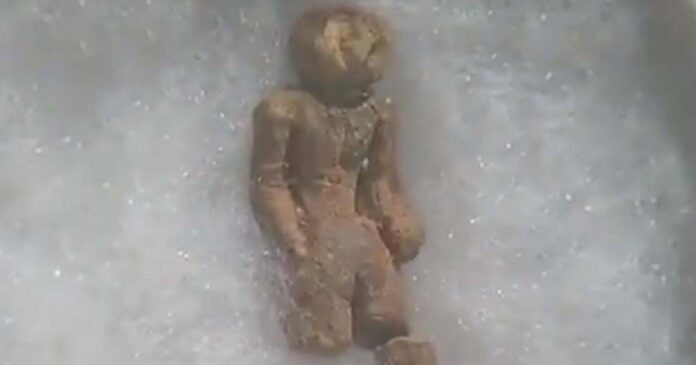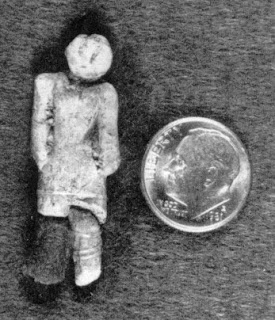
The mysterious story of the Nampa Figurine begins in 1889 near the town of Nampa in southwestern Idaho (USA). A group of workers was searching for water, so they started digging a borehole with a steam pump. Their goal was to create a well. When they got to 295 feet (90 meters) underground, dirt and bits of clay started being spit out of the hole. One of the pieces depicted a female human form – the so-called Nampa Figurine.
Here comes the most mysterious part: at such depths, the workers would have drilled through a geological formation which is approximately 2 million years old from the Pliocene-Pleistocene transition. This makes the figurine very out of place, as modern humans (Homo sapiens) who were capable of creating artifacts started developing 500,000 – 300,000 years ago according to modern science. In fact, the oldest undisputed example of a depiction of a human being is the Venus of Hohle Fels, which is dated “only” 40,000 – 35,000 years ago.
Our human ancestors from 2 million years ago, were known to use only the most simple tools as stones gathered from the ground. Moreover, there should have been no humans in the American continent at the time, not until 131,000 years ago. Therefore, the origin of the Nampa Figurine is mysterious, to say the least.

The artifact was later examined by scientists and professors. It is interesting that it is very small, almost the size of a coin. This is the description of Professor Albert A. Wright of Oberlin College from 1979:
“It was not the product of a small child or amateur but was made by a true artist. Though badly battered by time, the doll’s appearance is still distinct: it has a bulbous head, with barely discernible mouth and eyes; broad shoulders; short, thick arms; and long legs, the right leg broken off…There are also faint geometric markings on the figure, which represent either clothing patterns or jewelry – they are found mostly on the chest around the neck, and on the arms and wrists. The doll is the image of a person of a high civilization, artistically attired.”
Possible explanations
The most common theory presented by modern scholars is that the doll was made by modern civilization, perhaps by the Native Americans, which was somehow “pushed” deep in the geological stratum. It was suggested that this could have been done by fissures in the rock, volcanic activity, or mining. Some even argue that the drilling by the workers who found the Nampa Figurine could have caused it to fall so far below the surface. Skeptics are also backed by the fact that no similar artifact was ever found to be so old, not even close.
Another possibility brought forward is that the whole thing was a hoax or a prank. Even some of the explorers and geologists of the time like J.W. Powell did not believe that the figurine had any archeological value. He said that the object is extremely fragile and that if it falls to the ground if will shatter in pieces. So he did not believe that it was ejected from the borehole along with the other rocks.
Some of those who are more inclined to conspiracy theories say that intelligent humans might have existed in the much more distant past than originally believed. Others suggest that it could have been a remnant from extraterrestrial visitation.
The truth about the Nampa Figurine may forever remain a mystery, but the area where the artifact was found has been designated as a US National Natural Landmark known as Hagerman Fossil Beds National Monument since 1975. It is considered one of the world’s richest collections of plant and animal fossils that lived in North America just before the Ice Age. The Nampa Figurine can be seen on display at the Idaho State Historical Society in Boise.














